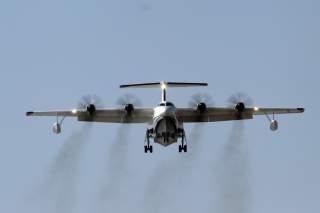Coming Soon to the South China Sea?: China’s AG600—the World’s Largest Amphibious Aircraft
Under peaceful circumstances, a giant seaplane would be more a matter of curiosity or commercial interest. But there’s nothing peaceful about the geopolitical situation in the South China Sea, where multiple nations—notably China—claim sovereignty over scattered islands and resource-rich waters
China’s AG600—believed to be the world’s largest amphibious aircraft—may soon be operational.
The transport plane—the size of a Boeing 737 airliner—has successfully conducted its first water takeoff and landing, according to China’s state-owned Xinhua news agency.
“At around 8:51 a.m., the plane took off from the surface of a reservoir near Zhanghe Airport of Jingmen under the command of captain Zhao Sheng and his crew,” Xinhua announced. “It landed smoothly and steadily on water after a fourteen-minute flight.”
China describes the AG600, built by the Aviation Industry Corporation of China, as a “large-scale special-purpose civil aircraft designed to assist with forest firefighting and water rescues.” It is part of a family of large aircraft that China is developing, including the Y-20 military transport and the C919 passenger jet.
The aircraft has four turboprop engines and has a maximum takeoff weight of fifty-four tons.
“The lower part of the aircraft body is designed as a ‘V’ structure to improve its anti-wave ability,” according to Xinhua. “When used to help put out a forest fire, it is able to collect twelve tons of water at a time and make multiple trips to fetch water. The aircraft can carry out sea rescue operations under complex meteorological conditions and can withstand two-meter-high waves. It is capable of carrying fifty people during a maritime search and rescue mission. It also provides support for China’s marine monitoring and safety patrol.”
The Xinhua announcement contained multiple references to the AG600 and its engines being domestically produced. Given that so many of China’s aircraft are based on Soviet and Russian models, this is a signal that China’s indigenous aviation industry is coming of age.
Under peaceful circumstances, a giant seaplane would be more a matter of curiosity or commercial interest. But there’s nothing peaceful about the geopolitical situation in the South China Sea, where multiple nations—notably China—claim sovereignty over scattered islands and resource-rich waters.
An amphibious aircraft that can carry fifty passengers can also airlift an infantry platoon to a disputed island. An amphibious aircraft can deliver troops and supplies by landing in the water, rather than relying on airfields that will be prime targets for air and missile attack.
So, China’s neighbors can be forgiven for a bit of skepticism that the AG600 is an aerial Smokey the Bear that will put out forest fires. Indeed, Asian military observers say the AG600 can support Chinese island bases in the South China Sea, as well as provide an excuse for Chinese aircraft to operate over disputed areas under the guise of maritime rescue missions.
Recommended: Imagine a U.S. Air Force That Never Built the B-52 Bomber
Recommended: Russia's Next Big Military Sale - To Mexico?
Recommended: Would China Really Invade Taiwan?
China isn't alone in embracing amphibious aircraft. Russia operates several Soviet-era amphibians, as well as exotic "ekranoplan" aircraft-boat hybrids, such as the notorious "Caspian Sea Monster."
On the other hand, amphibious aircraft trade off performance in return for the ability to land on the water. During World War II, Japan fielded floatplane fighters and bombers, including the A6M2-N (Allied code name "Rufe"), an amphibious version of the famous A6M "Zero" fighter. In the wide expanses of the Pacific, where airbases were few and far between, they could be useful. But against Allied land- and carrier-based fighters unencumbered by pontoons, a Rufe stood little chance.
Not that any transport plane would fare well against modern jet fighters and air defenses. But the world’s largest seaplane will either need to operate in undefended areas, or have plenty of escort.
Michael Peck is a contributing writer for the National Interest. He can be found on Twitter and Facebook.
Picture: Reuters.


